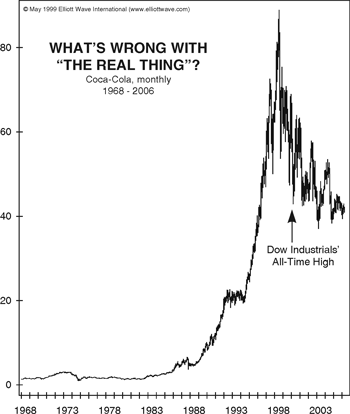If it’s not one problem for Coca Cola (see entry of December 30), it’s another (see entry of July 15). Now even Coke is joining the anti-Coke crowd and voluntarily withdrawing from schools due to pressure from the anti-obesity crowd. But the rising incidence of obesity is like the performance of Coke’s stock over the last six years (shown in the chart below), both are divergence against the final thrusts of a century-long bull market.

"Things" always go against Coke in a big bear market. In a socionomic history of Coca-Cola, the December 1999 issue (see July 15 Additional References) of The Elliott Wave Finanicial Forecast illustrated how government and other cultural forces gang tackle Coke when the mood turns down. A parallel to the current situation, for instance, is a steady stream of attacks that came Coke’s way through the mostly bearish span of 1906-1920:
As the bear market dragged on, Coca-Cola was beset by woes. In 1908, the U.S. government filed suit over its labeling and employment practices. “Even though Coca-Cola won the case in 1912, the publicity hurt the drink. D.W. Griffith put out an anti-Coca-Cola epic in which the inventor of ‘DOPOKOKE’ watched his son fall prey to the drink’s cocaine. ‘The drink no longer satisfies,’ read one caption as the young man went on to hypodermic injections.” Through the end of the 1910s, Coke was riled by rocketing sugar prices and a “civil war” for control of the company. After a “disastrous” year in 1920, Coca-Cola finally righted itself in 1922, a year after the Dow bottomed.
Coca-Cola’s real “secret formula” is its ability to use marketing jingles, images and celebrities to graft its product into the bull market psyches of consumers. As in 1906-1920, Coke finds itself running through top executives and continually backpedaling from the emerging anti-Coke mob because its bull market imagery is at odds with the unfolding trend. The updated chart shows just how out-of-step Coke is with recent all-time highs in several averages. The arrow on the chart shows that Coke really did turn out to be the "real thing" right before the bottom fell for the rest of the market in 2000. The current divergence is even larger and should prove just as informative. |
